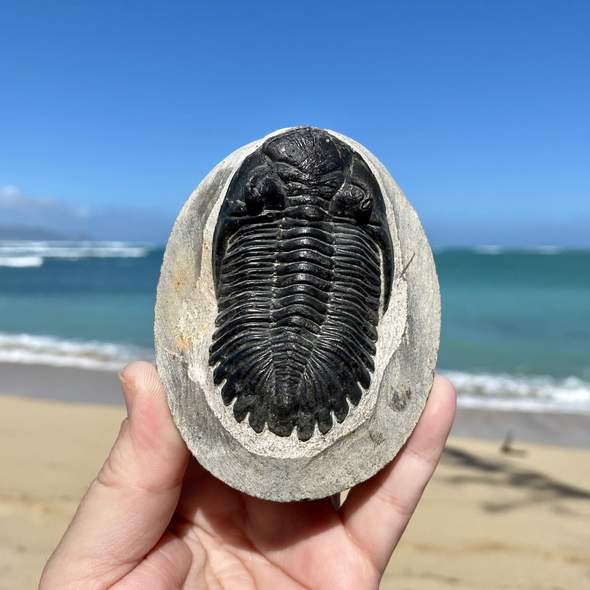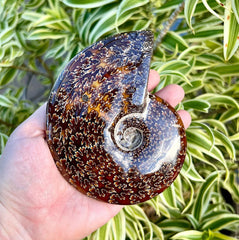
Fossils: Everything You Need to Know
Ever find yourself fascinated by fossils? Curious about the mosquito fossil in amber perched at the top of John Hammond’s cane in Jurassic Park? Swooning over the dragonfly fossil in amber presented to Claire Fraser by Hugh Munro in the dreamy hit television show Outlander? Perhaps, despite being mesmerized, you wonder exactly what is a fossil and where do they come from?
What is a Fossil?

From the Latin word “fossus,” meaning “having been dug up,” a fossil is the remains of prehistoric life, especially those preserved in rock before the end of the last ice age. A fossil can be an animal or plant itself or the imprint of an animal or plant. Fossilization turns the animal or plant into rock, replacing materials with harder minerals through “mineralization.” If an animal had hard parts, it is more likely to be fossilized, while softer animals like insects and worms are unlikely to become fossils. A small percentage of species have been fossilized, meaning that almost all living things that have ever inhabited the earth leave no fossil type or any other trace that they ever existed.
Fossils represent the remains or traces of once-living organisms. While there are multiple ways of sub-categorizing types of fossils, there are four main types.
4 Main Types of Fossils:
- Mold fossils: this fossil type is an impression made in the substrate; it is a negative image of the organism.
- Cast fossils: this fossil type is formed when a mold is filled in.
- Trace fossils: the most common fossil type, trace fossils consist of fossilized nests, burrows, footprints, etc.
- True form fossils: this fossil type is of the actual animal or animal part

So, what is a fossil in simple words? It is essentially the most beneficial window to the history of life on earth. Fossils tell us much about what was here long before we came to be.
Where Are Fossils Found?
Where they are found depends on what type of fossil you are looking for. Fossils are more likely to be found near water. Plants and animals that die near water are more likely to be covered by sediment, starting the mineralization process. A plant or animal that dies in a large, open plain is more likely to be scavenged and decay, leaving little to nothing behind to become a fossil. For this reason, our knowledge of the history of life on earth is weighted heavily towards marine life.
Fossils have been found on every continent on Earth and exclusively in sedimentary rocks. Why only sedimentary rocks? Sedimentary rocks are created from accumulated sediment, such as silt, sand, and skeletal remains. Igneous rocks are formed from lava or magma that has cooled but are too hot and would have destroyed the plant or animal before a fossil could form. Metamorphic rocks are sedimentary or igneous rocks that undergo tremendous heat and pressure and are altered significantly, destroying all fossil evidence.
How Do I Find a Fossil?

Fossil hunting is a simple, exciting activity for all ages! Whether you are looking for trilobites out west or megalodon teeth on the East Coast, you can find buried treasure all over the country. Not every state is perfect for fossil collection, but most have an opportunity for a prehistoric connection—even if it is in the air-conditioned confines of a local museum. While it is widely accepted that a reasonable number of fossils can be removed from public lands, it is always wise to be familiar with the laws for fossil collection in the state you plan on digging in.
Great Locations to Find a Fossil:
- Westmoreland State Park (megalodon teeth)
- Big Brook Park (teeth and vertebrae of goblin sharks, mackerel sharks, crow sharks, angel sharks, sawfish, rays, drum fish, and saber-tooth salmon)
- U-Dig Fossils (trilobites)
Wherever you go to find fossils, you will want to bring a small brush (toothbrush or paintbrush) and a bottle of water or spray bottle to clean dirt off fossils in a fossil pit. If you are splitting shale, you may want to add gloves and protective eyewear. In a river, a sifting pan and a bucket are all that will be needed to find those ancient treasures. Comfortable clothes with deep pockets will keep your tools at hand, and plenty of water, snacks, and sunscreen will keep you on the hunt all day!
Where Can I Buy a Fossil?
Not interested in becoming the next Jack Horner, World-Renowned Paleontologist? If you are not exactly the outdoors type, digging up bargain finds in a store can be just as invigorating. You can find fossils of all kinds in gift shops and nature stores, but you will still want to know what a fossil is?
Take time to research the type of fossil you are interested in buying and compare pricing at a couple of reputable suppliers. Once you determine the fair price for a couple of fossil types you are interested in, you can use that as baseline pricing at any rock shop you peruse to make sure you are charged a reasonable price. Keep in mind – price is not the only factor! Size, quality, and variety are important considerations as well.
Looking for a seriously big fossil investment? Stan, the largest fossilized Tyrannosaurus Rex ever discovered, sold last year at auction for $31.85M. The 67-million-year-old specimen is one of only fifty ever discovered, with 188 bones and its head in perfect condition with 11-inch-long teeth. Paleontologists say that Stan would have weighed about seven to eight tons in his prime and showed signs of a rather violent life. His neck was broken, and he had a puncture in his skull and ribs. Stan took 30,000 hours to excavate and was completely worth the wait!
Whether it’s Stan, a dragonfly in amber, or a mosquito-topped cane, these ancient discoveries can ignite the spark of curiosity that propels you to uncover the answer to “what is a fossil” and how can I find them? Knowing what a fossil is, what to look for in a fossil, and where to find them is only the beginning of the journey. By studying fossils– the remains of life and the traces they left behind– we can learn about how animals and plants lived and behaved millions of years ago. A great way to fan the flame of curiosity is to find a purveyor of fossils who is knowledgeable, experienced, and excited to share the journey with you!

